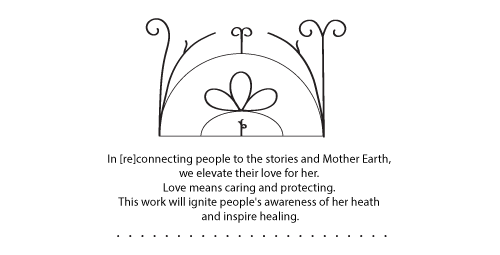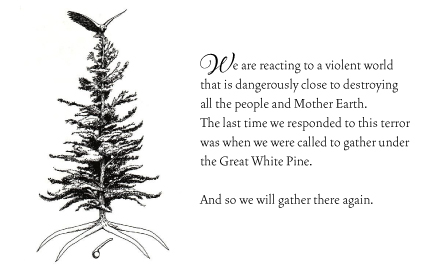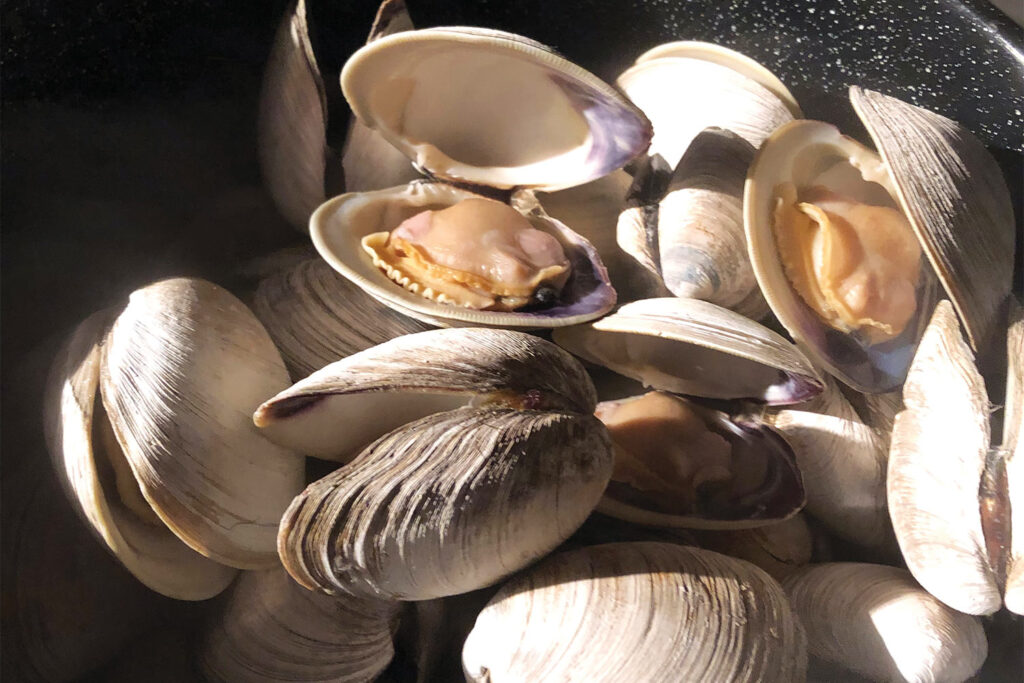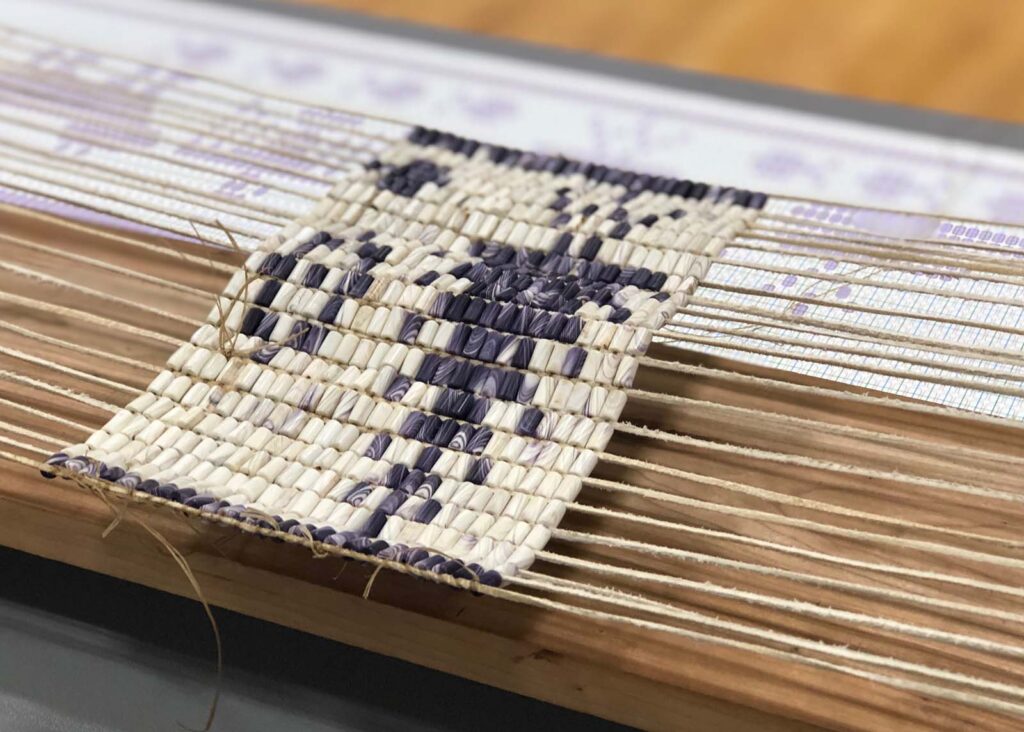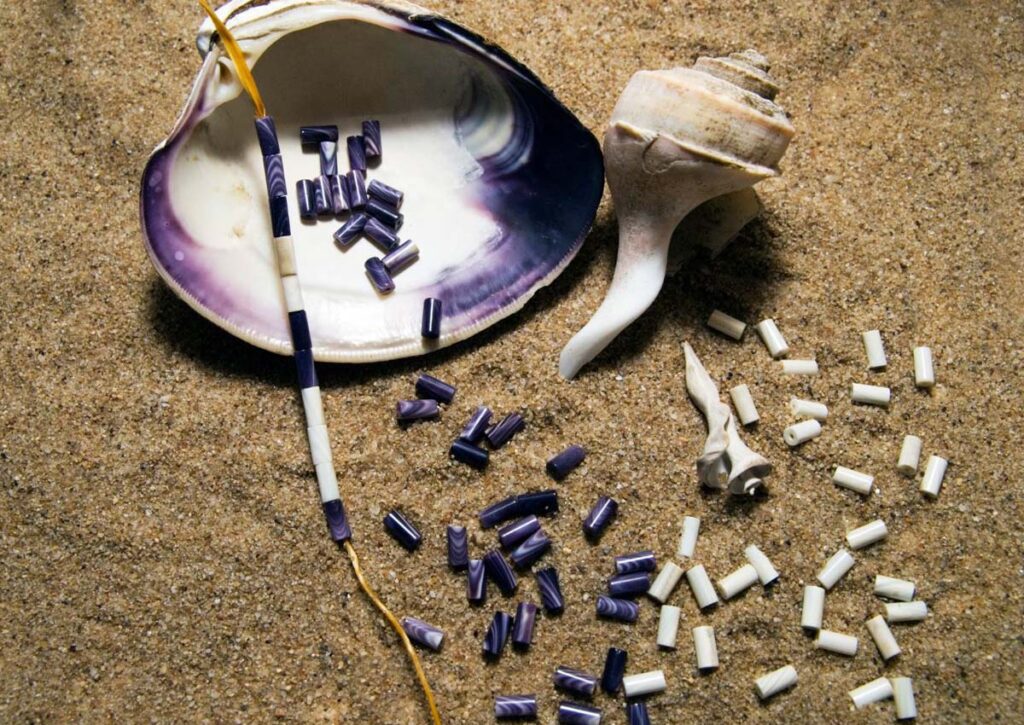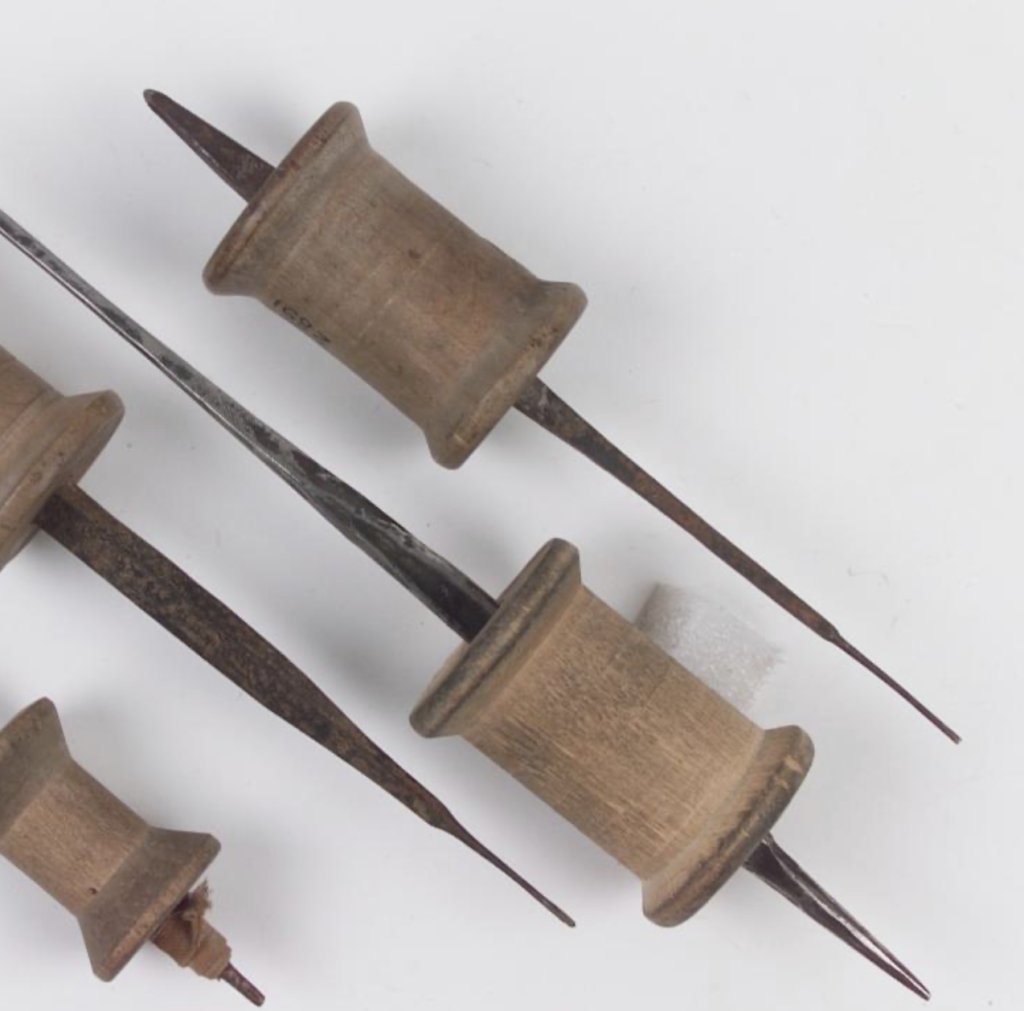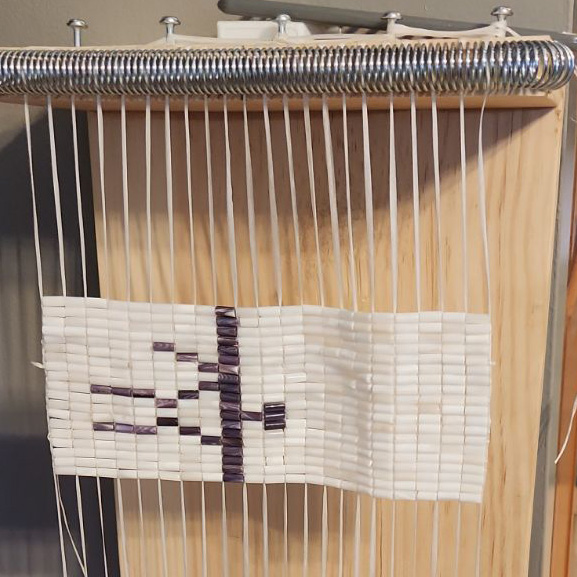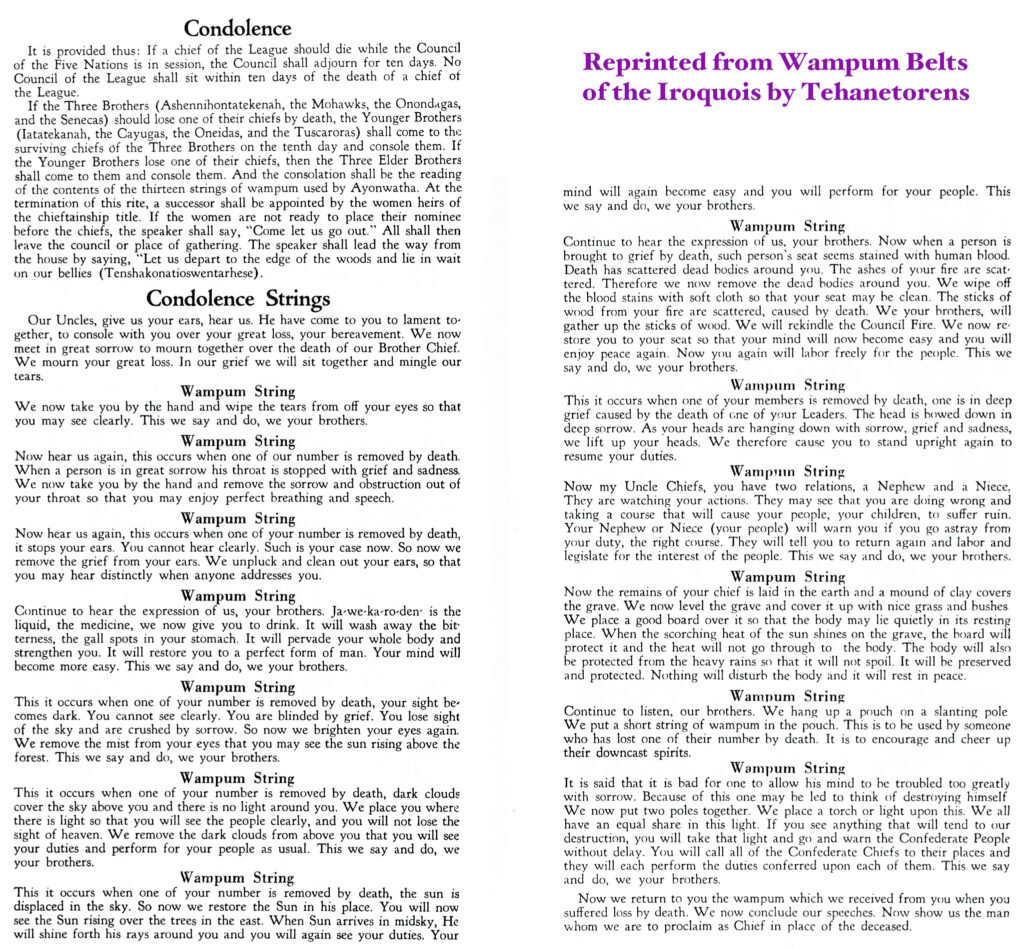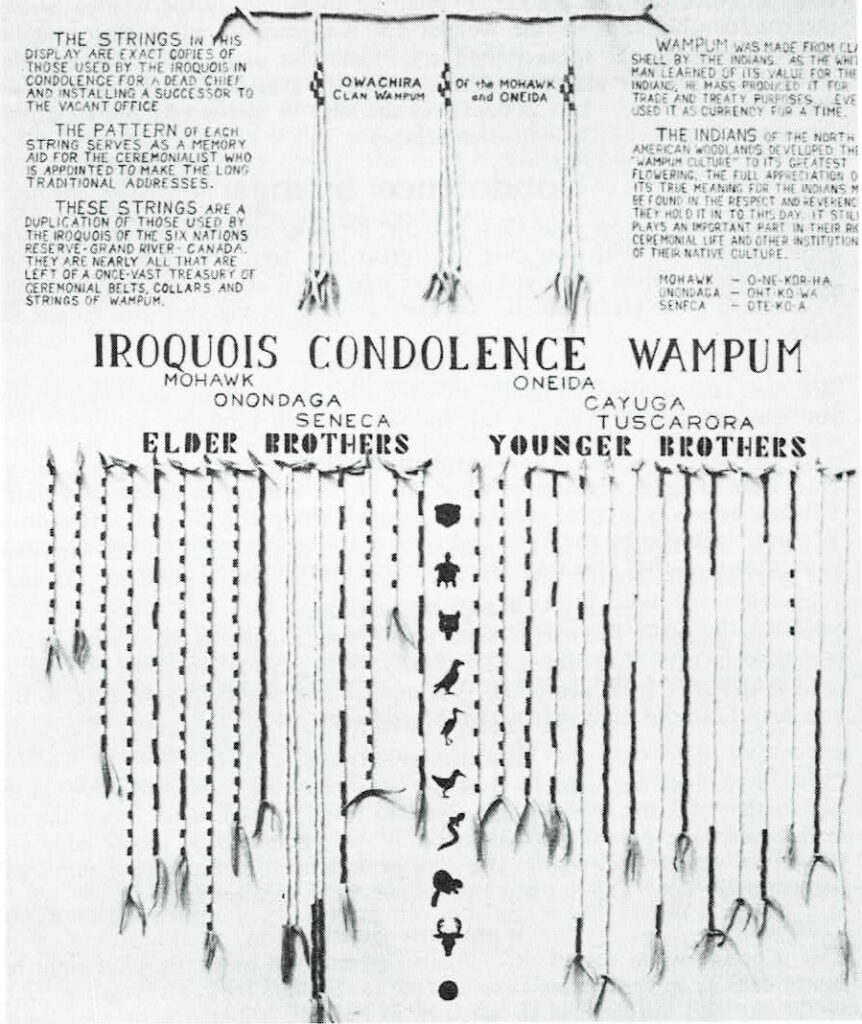Wampum, Belts and Strings
Otgó'a | Onekorha | Oneké:rha' | Wampum
Oión:wa | Wampum Belt
Kaión:ni | Ka'swénhtha | Belt
There are many variations of Mohawk words found when speaking of wampum and belts and they are as fluid as the Haudenosaunee languages themselves. However spelled and pronounced, wampum is a vital part of our cultures.
Wampum is the shell of northern Quahog (pronounced: coe-hog); a clam found in the Atlantic coast's shallow bays and sandy bottoms from Nova Scotia to Florida. Southern Quahog can be found in the Gulf of Mexico. It's important to be mindful that this is a living being and was a prized food (and still is) for many eastern Indigenous nations. After eating, the shells of all clams would be used for making tools and beads. The animals that produces the white bead (whelk) actually eats the animal that produces the purple bead.
To create beads from shells is arduous and the dust can be dangerous. Pieces of the shell are broken, filed and smoothed into tubular beads and then drilled to make the hole; most who do this work do it with the shell submerged in water. There are very few makers of beads.
In beading with wampum, one is creating a living record, agreement or telling a story and it is extremely important to be mindful of this sacred way of knowledge sharing. It is a process of spirit and should not be taken lightly; speaking your intentions and using the loom, touching the materials must be done with good mind. Whatever surrounds you while you work will flow through your hands and into the piece. This is taught to us of food as well; cooking or harvesting when angry or sad will result in those feelings passing through to the person who eats. Create with good intentions, surrounded by kindness and in full acknowledgement of the lives that the materials and tools once led as part of Creation.
If you hold a string of wampum in your hand, you are speaking only the truth and the people that are being spoken to are very respectful of the message. Generally, and according to stories of Aiwaatha/Hiawatha, the white beads represent peace, the purple represent grief and/or darkeness. So with that in mind we are reminded that it takes both good and bad to create balance; this is what the twins, Kanehtó:ton and Okarahtsikó:wa taught us.
Archaeological evidence shows that wampum was in use by the Haudenosaunee in the period before the Haudenosaunee Confederacy. However, it is unclear how native americans made wampum beads from shells prior to colonization. Resources suggest we used a flint, stone or reed chipped into a drill-like tool and shaped the beads cylindrical with stone friction. It is also noted that wampum belts were made with string from plant fibres or sinew. Below is a photo of a tool used by a non-native shell factory, Shell drill, Campbell Wampum Factory (Campbell’s Wampum Factory, New Jersey, non-Indian), 1746-1889, https://americanindian.si.edu/collections-search/objects/NMAI_142929
*Important to note that some scholars suggest that reeds and Eagle feathers were also used to create belts.
You can continue to explore and review more scholarly research on the resource page.
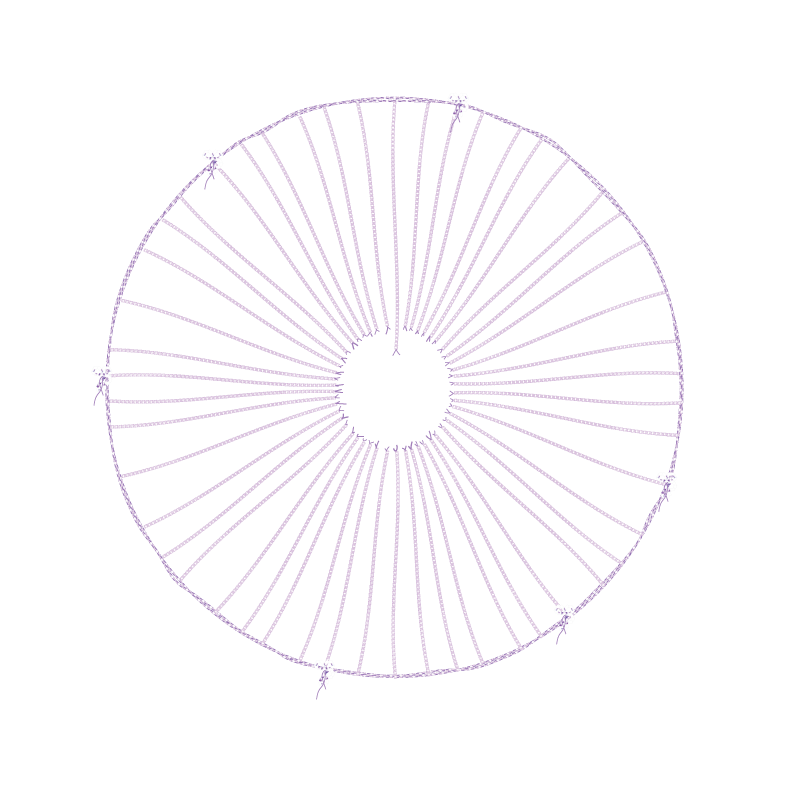
Circle Wampum | Circle of the Fifty Sachems
The circle of white wampum represents the seating of the fifty sachems of the Haudenosaunee Council. The confederacy has fifty hereditary chiefs who are nominated by Clan Mothers: 9 Oneida, Fourteen Onondaga, 9 Mohawk, 10 Cayuga and Eight Seneca all being equal and united in good mind. Some will teach that the chiefs are holding hands to create a strong circle of people who follow the ways of creation; one not being of good mind, must leave the circle and if a chief, he could be dehorned by the Clan Mother.
There has been a call from the women to fill these positions expressing that the positions can be held by the matrilineal leader of any family and that those women should not hesitate to let their intentions be known. According to the Haudenosaunee Confederacy (from a possibly outdated chart), there are many empty positions for the Clan Mothers; Mohawk 44% filled (6 positions vacant), Seneca 81% filled (2 positions vacant, Onondaga 86% filled (3 positions vacant), Cayuga 85% filled (3 positions vacant, Oneida 78% filled (0 positions vacant) and Tuscarora has both positions vacant.
Women's Nomination Belt
Tsiokonsaseh or Jikonsaseh or Mother of Nations / Peace Mother was Peacemaker's collaborator and the first Onkwehonwe/Ögwe'öweh to share the message of peace. As the Mother of Nations, Tsiokonsaseh structured a society where where Clanmothers were responsible for nominating chiefs and they could dehorn chiefs. They led survival by delegation; each member of the community contributed equally to a well run, reciprocal and productive society. Clan mothers also held and appointed all of the names for all of the people.
Since Jikonsaseh, Haudenosaunee/Hodinöhsö:ni' society was matrifocal and matrilocal. Each longhouse was run by the matrilineal lead alongside of her sisters and daughters, all married couples lived in the wife's mother's house. Generally, men were away and returned to surrender hunting harvests to the women and to attend seasonal ceremonies. Women were the meat distributors, farmers and farm harvesters, decision makers and overall caretakers of longhouse economy.
Collectively, women owned the houses, the farms, the harvests and held the political capacities - never forgetting the value of the men, the communities and families always maintained peace and upheld equitable perspectives of gender.
To this day, the Women's Nomination Wampum Belt honours monumental positions of Haudenosaunee women. Purple shells/beads create six figures who are the international clan mothers. The solid purple line represents the strength in unity; they hold hands in their authority to govern houses, lands and clan names. A reminder to the importance of maintaining a strong council fire is represented by the square of purple beads in the middle.
The white clam shell beads represent the women embraced in peace or skennen, the kariwiio (good message) or enyonkwa'nikonhriyo:hake (good minds).
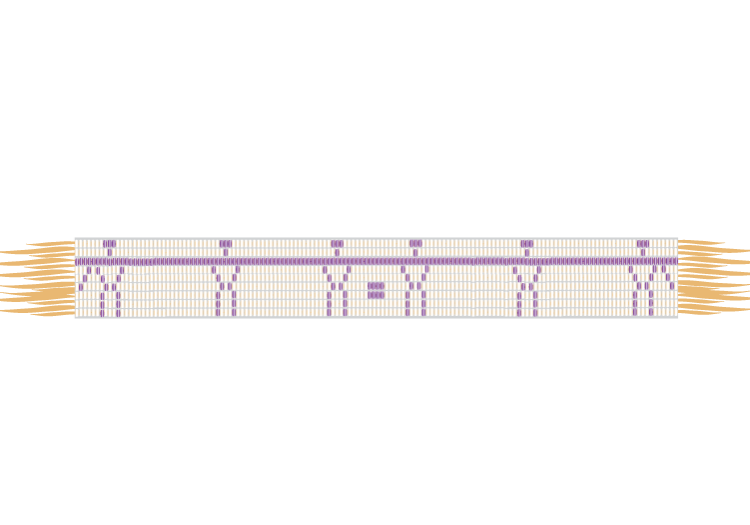
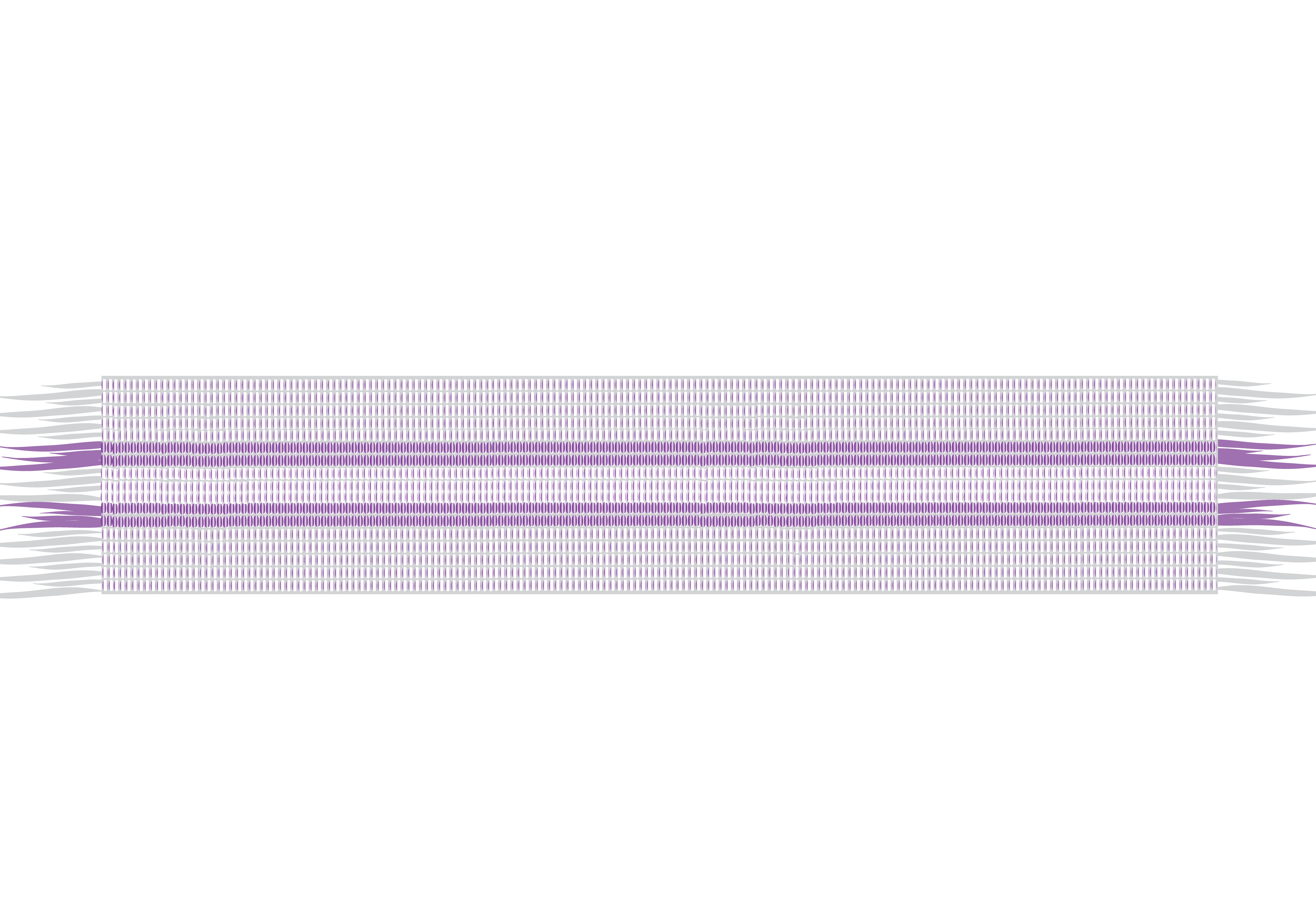
Gaswénda | Kaswénta | Two Row Wampum
Around 1613, the Kanienkehá:ka (Mohawk) people saw the Salt Water People coming to their communities. The new people were cutting all the trees and clearing land. Worried, the Kanienkehá:ka sent a runner to Onoñda’gegá’ (Onondaga) to have a meeting with Tekanawi:ta(Peacemaker) about this and together the Hodinohso:ni | Haudenosaunee Confederacy decided they would all go to speak with the newcomers (the Dutch).
Through long times of talking, they all agreed that the two groups of people would go forward as ‘brothers’, They felt that being brothers would establish an honest and respectful relationship based on equality and unity. This is called the Kahswentha or Two Row Wampum Treaty.
On that relationship of brotherhood, the Dutch wrote on paper but the Hodinohso:ni created the Two Row Belt because they knew it would last forever and so would their promise.
The belt was created from the most treasured white and purple Wampum beads (Quahog shells); one long row for the big ship of the Salt Water People and one long row for the canoe of the Onkwehonwe and 3 rows in the middle that symbolized the peace, friendship and forever boundaries between. And so it was agreed that the two ships would move forward side by side - neither one would attempt to steer the other’s boat and they would never cross each other’s paths.
It was understood by the Onkwehonwe that this agreement was permanent and for ever ...as long as the grass is still green. The grass is still green and the Hodinohso:ni kept the promise; they never told the new people how to live. But the new people changed everything about the Onkwehonwe including language, spirituality, health, community and family.
Hiawatha | Ha:yëwënta' Belt
Understood as the national belt of the Haudenosaunee and is named after Hiawatha, the Peacemaker's helper. A grief stricken Hiawatha suffered intense pain after Tadodaho killed his daughters. Hiawatha and didn't think of peace until he found himself crying tears into a lake. The ducks saw his grief and knew that if they flew up in the most powerful manner, that they could give Hiawatha the gift of condolence and peace, and so they did. They flew with such might that the waters retreated and left in the sand were shiny purple and white shells, wampum.
With the purity of these shells, Hiawatha used them to wipe his tear stained eyes, clear the memory of screams from his ears and clear his mind of the debilitating grief. His process of healing is now called the condolence ceremony and he shared this peaceful way of healing and the shells that he had collected with all of the representatives of the nations.
Alongside Peacemaker and Tsiokonsaseh, they visited each nation with the wampum to unify all the leaders, in the end bringing them all together under one longhouse - even Tododaho, who was overwhelmed by the love and maternal attention of the Peace Mother, joined them.
In about the year 909, under a full solar eclipse, all of the nations gathered under the Tree of Peace. They had each made a string of beads from their wampum shells and as a symbol of unity and peace. The Peacemaker weaved all the strands into one belt and begins to declare the benefits and fulfullness that peace brings. The Tree of Peace was lifted out of the earth and into it's hole was thrown all of the weapons of war. The weapons remained buried there forever and all the people agreed that all war would end between the nations and they would live in peace eternally. They would share all of the gifts of Creation and live in harmony and contentment.
Each rectangle of the Hiawatha Belt is made with purple shells and outlines the representatives of each nation. In the east, the first rectangle represents the Mohawk, the second is the Oneida, in the centre is the Tree of Peace and the Onondaga, then the Cayuga and on the far right, the Seneca.
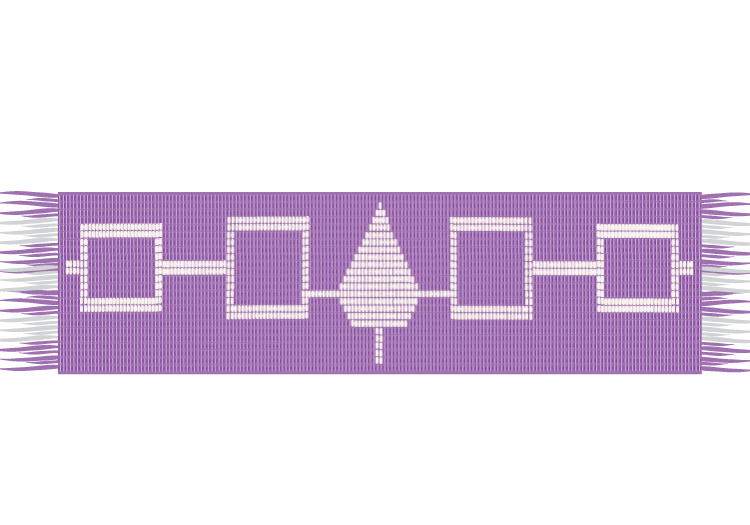
Important Considerations for Women
Some Haudenosaunee may say that women should not make wampum belts.
Are women excluded from making wampum belts?
Can women make them but not hold the completed belts?
“Women were employed to make belts by French, English and Americans. Because of their innate spiritual powers during their cycles (mentrual powers), we believe they could remove the sacredness of the belt. So women don’t handle the medicine objects. Historic records show times when women verbally remind people of the stories in the belts. Women remember all the words and remind us, women are the oral historians, they teach the stories to the children. There are some wampum that women bestow and use, women hold a significant role, they asked the men to hold the belts, as was their power to do so given their positions in the community.” Rick Hill, Six Nations of the Grand River, February 22, 2024, McCord Museum, Symposium .
This information is presented to you so that you can make your own decisions based on what you’ve learned.
- Perhaps we can say that things have changed, women can contribute to our stories.
- Perhaps we can say that women should not touch wampum belts while on their Moon time (menstrual cycles).
- Perhaps we can say that women can make them but not hold the completed story once it’s finished.
However you decide, we support you as long as we all agree that wampum is the core mechanism of relationships and agreements and we are spiritually bound to consider all the implications and importances of the creation, meaning and eternal story woven into our belt.
This is not a comprehensive list of images, language or research. Nor are the stories or descriptions written by scholars (with the exception of cited research links). This site is meant to be general information and condensed stories for those who are interested in beginning their learning journey and/or seek a better understanding of the 2024 eclipse and the matrilineal ways of the Haudenosaunee. You may also find spelling and language discrepancies, please encounter them with an open mind to the fluidity and complex nature of our dialects and language.
At the time that we joined together to ratify the Kayanare(n)kówa (Great Peace), some say that a total eclipse darkened the skies so deeply that the nocturnal animals woke to encircle and witness the calm of the people who unified under the Great White Pine. As our brother the Sun re-emerged from behind the kindness of Grandmother Moon, all Onkwehonwe were awakened with a new sense of balance and unity and we intend to walk in unity until the end of time.
Some kononkwe (women) are weaving the significance of the eclipse at the time of Kayanarekówa into the one that happened in 2024. In this world of war, we are reminded of the monumental role that Peace Mother, Tsiokonsaseh played in establishing unity, equality and peace among the nations.
We are calling in peace now and we are elevating Peace Mother and our voices to call for reunification.
Foundational to Haudenosaunee identity is the transmission of feminine knowledge, social structures and diplomacy and we have found a time and place to recapture that way of understanding; under the sky, hand in hand, in song and in a display of effeminate matrilineal power.
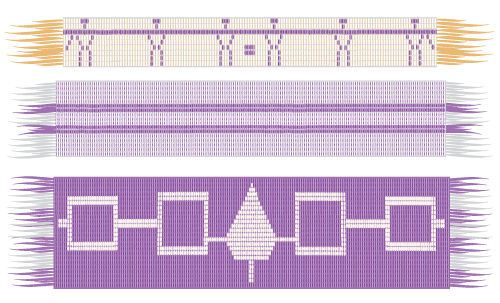
"Woman is the first environment. In pregnancy, our bodies sustain life. At the Breast of women, the generations are nourished. From the bodies of women flows the relationship of those generations both to society and the natural world. In this way the earth is our mother, the old people said. In this way, we as women are earth"
Katsi Cook, Mohawk Midwife, Akwesasne
